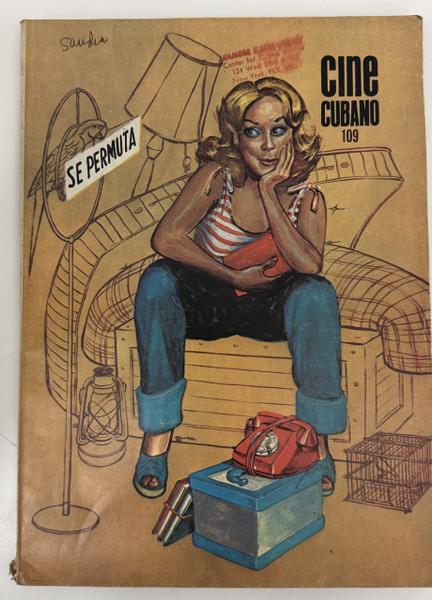- Travel
-
Exhibits
- La Portada Cubana
- Immortal Cuba: Artists Take on Their Heroes
- Seattle Poster Exhibit
- Sandra Dooley & Alejandrina Cué
- The Art of Wayacón
- Cuban Folk Art
- Cuba In Black And White
- 25 Years of Cuban Art Space
- Summer Folk Art Expo
- ¡SPRING AWAKENING FROM CUBA!
- Celebrating The Art Of Cuban Women
- Celebrating Paper, Affordable Art from Cuba
- Art of the Revolution
- Outsider Art
- Lost and Found
- En la lucha: Celebrating Cuban Women and Their Art
- Cuban Art Stash
- 100 Fires: 5 Cienfuegos Artists' Work on Paper
- Waya + Monte! Magic Realism in Cienfuegos
- Viva Cuba Viva! Poster Show
- Cultivando Sueños
- Black Lives Matter in Cuba Jan 9-March 27
- Leandro Soto: Crónicas visuales
- Cuban Canvas
-
Archive
- Global Reflection 2018: Spirit and Community
- Exhibit in the cloud: Contemporary Works on Paper
- MADE IN CUBA! MINNEAPOLIS EXHIBIT
- Cuban Posters and Photography from CCS collection
- AUTUMN SALE! Sept/Oct 2017
- SPRING ARTS AND CRAFT SALE
- Vuelo Directo/Non Stop: Alberto & Alejandro Lescay
- The Many Faces of Fidel
- Somos
- Made in Cuba!
- The US empire in Cuban graphics
- Made in Cuba/Seattle exhibit
- Entre Nos
- Looking Back
- Cuban Art Space
- Membership/Donate
- About Us
- Cuba News
-
Guillermo H. Benítez's playful cover illustration for Cine Cubano 109 features a pin-up style portrait of legendary Cuban entertainer Rosita Fornés, rendered in warm watercolors against a kraft paper background. The actress sits casually on a wooden crate marked "SE PERMUTA" (for trade/exchange), surrounded by sketched outlines of everyday Cuban objects—a floor lamp, an old-fashioned telephone, books, and other domestic items. Dressed in a red and white striped top with bell-bottom jeans and platform shoes, Fornés embodies a nostalgic glamour with her blonde bouffant hairstyle and coquettish expression, hands playfully framing her face. The combination of fully rendered figure and line-drawn objects creates a dynamic visual contrast, while the "SE PERMUTA" sign references Cuba's informal barter economy. Holbein's overall design balances this whimsical illustration with bold black typography for "cine cubano 109" in the upper right corner.
Published in March 1984 to commemorate the 25th anniversary of the Revolution's triumph, this issue of Cine Cubano—the official magazine of ICAIC (Instituto Cubano del Arte e Industria Cinematográficos)—opens with a "Carta a Fidel" addressing Castro as Comandante en Jefe and President of the Council of State and Ministers. The letter celebrates Cuban cinematography's first 25 years, acknowledging early challenges when necessary credits and resources were scarce. The magazine honors those who helped establish ICAIC's foundations, those who maintained its presence in festivals and markets, and those with infinite passion for truth and optimism who set the course for Cuban cinema's future.
Directed by Julio García Espinosa and edited by Luis Rogelio Nogueras, this issue includes diverse content: articles on 25 years of Cuban cinematography, profiles of filmmakers like Saúl (the "indomitable optimist"), poetry by Rafael Alberti, analyses of Chilean cinema in exile (1973-1983), and examinations of Montiel's widow and the lost hunters of the Arca region. The choice of Rosita Fornés for the cover—a performer who bridged pre- and post-revolutionary Cuban entertainment—represents continuity in Cuban popular culture while the surrounding "permuta" objects suggest the resourcefulness and material realities of revolutionary life. This issue captures Cuban cinema at a moment of mature reflection, looking back on a quarter-century of revolutionary filmmaking.
-
-
Discover More at the Center for Cuban Studies





![Instituto Cubano del Arte e Industria Cinematográficos / ICAIC (layout: Holbein, cover designer: Reboiro (Antonio Fernández Reboiro), director: Alfredo Guevara), "Cine Cubano" issues 76/77, [1976-1977]. Offset print, magazine.](https://cdn10.bigcommerce.com/s-ufzvo/products/5903/images/6490/IMG_8817__13591.1761537538.200.200.jpg?c=2)
![Instituto Cubano del Arte e Industria Cinematográficos / ICAIC (layout: Holbein, cover design: Reboiro (Antonio Fernández Reboiro), director: Alfredo Guevara), "Cine Cubano" issues 78/79/80, [1978-1980]. Offset print, magazine.](https://cdn10.bigcommerce.com/s-ufzvo/products/5904/images/6491/IMG_8819__36889.1761600195.200.200.jpg?c=2)
![Instituto Cubano del Arte e Industria Cinematográficos / ICAIC (layout: Holbein, cover design: Tony Fernández Reboiro, director: Alfredo Guevara), "Cine Cubano" issues 54-55, [1969]. Offset print, magazine.](https://cdn10.bigcommerce.com/s-ufzvo/products/5905/images/6493/IMG_8821__07256.1761600194.200.200.jpg?c=2)